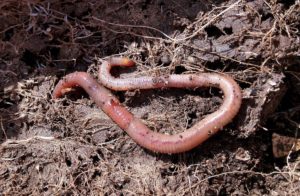Carbon Gardening: Less Work, Less Expense
To protect the humus from breaking down, when feeding plants, dress the soil with compost and let the worms carry the organic matter down into the soil.
By Thomas Christopher
Thanks to an article in the Ecological Landscape Alliance newsletter, I recently met – first online, and then by telephone – a very interesting gardener in Illinois named Adrian Ayres Fisher. Adrian is the Sustainability Coordinator for Triton College in River Grove, a suburb just 14 miles northwest of downtown Chicago. As the college’s sustainability coordinator, Adrian has many duties, but gardening is her passion, and it has led her to take a special interest in the landscaping of the college’s 110-acre campus.
“Carbon gardening,” a school of gardening aimed at extracting carbon dioxide gas from the atmosphere and sequestering its carbon component in the soil, informs many of her activities in this area. This may sound arcane, but in fact, carbon gardening is something that should concern anyone with a piece of land to cultivate. Carbon dioxide, after all, is the principal “greenhouse gas” responsible for the ongoing increase in global temperatures, and more locally, for the upheavals caused by climate change. We’ve been seeing an increase in the concentration of carbon dioxide in the Earth’s atmosphere since the beginning of the Industrial Revolution, when we first began burning fossil fuels on a large scale. In 2018, the most recent year for which I could find figures, the United States alone released 5.4 billion metric tons of carbon dioxide into the atmosphere. If this transformation of the atmosphere continues unchecked, the consequences are going to bring dire dislocations over the coming decades.
What can you or I do about that? Change the way we garden, says Adrian Fisher. At Triton College and in her own backyard, Adrian practices a very different style of cultivation. If we all took up this sort of gardening, she says, and applied a similar approach to farms and public lands, we could cut our carbon dioxide emissions by possibly as much as a third. In the United States, Adrian points out, that would be a reduction equivalent to taking all of our cars and trucks off the road.
Changing our farming practices and public land management is, admittedly, a challenge, but not so transforming the way we manage our yards. Carbon gardening on that scale is easy, and it brings many other benefits, including less expense and less work.
The first step is to recreate in our yards something like the sort of natural plant communities that existed in our area before the landscape was cleared for farming and home construction. We can accomplish this by planting complexes of compatible native trees, shrubs and herbaceous plants. We don’t have to be purists. Adrian admits that she cultivates around 20 percent non-natives in her yard.
If, however, you cultivate mostly native plants that evolved together, that will set in motion a transformation of the soil. Water and carbon dioxide absorbed by plant leaves will be turned into glucose. The glucose, in turn, will not only feed plant growth; it will, when secreted by the native plant roots and the network of fungi that inter-connect them, nourish a wide range of microorganisms and soil-dwelling creatures and promote the production of humus. If left undisturbed, this dark organic matter, which is 60 percent carbon, can persist in the soil for centuries or even millennia. That’s why an essential second step in carbon gardening is eliminating digging and mechanical tillage; if you expose the humus to the air, it will break down. So, if it becomes necessary to feed your plants, dress the soil with compost and let the worms carry that organic matter down into the soil.
Because the native flora is adapted to the local soils, it should be able to flourish without added fertilizers, especially the synthetic fertilizers whose manufacture requires massive inputs of fossil fuels. Native plants are also better adapted to subsisting on the natural complement of precipitation, so after they are rooted in, they should not need irrigation.
All of this means less work for the gardener and less expense, which makes carbon gardening personally as well as environmentally appealing. Likewise, the native plants will also feed native pollinators and insects that are the basis of the food chain for birds and other wildlife. In other words, this is not just a win-win situation; it’s better than that, with many more benefits. Why don’t you join Adrian—and me—in giving it a try?
If you want to learn more about carbon gardening, you’ll find an interview with Adrian Ayres Fisher at thomaschristophergardens.com/podcast.

 Thomas Christopher is the co-author of “Garden Revolution” (Timber Press, 2016) and is a volunteer at Berkshire Botanical Garden. berkshirebotanical.org Be-a-Better-Gardener is a community service of Berkshire Botanical Garden, one of the nation’s oldest botanical gardens in Stockbridge, MA. Its mission to provide knowledge of gardening and the environment through 25 display gardens and a diverse range of classes informs and inspires thousands of students and visitors on horticultural topics every year. Thomas Christopher is the co-author of Garden Revolution (Timber press, 2016) and is a volunteer at Berkshire Botanical Garden. berkshirebotanical.org.
Thomas Christopher is the co-author of “Garden Revolution” (Timber Press, 2016) and is a volunteer at Berkshire Botanical Garden. berkshirebotanical.org Be-a-Better-Gardener is a community service of Berkshire Botanical Garden, one of the nation’s oldest botanical gardens in Stockbridge, MA. Its mission to provide knowledge of gardening and the environment through 25 display gardens and a diverse range of classes informs and inspires thousands of students and visitors on horticultural topics every year. Thomas Christopher is the co-author of Garden Revolution (Timber press, 2016) and is a volunteer at Berkshire Botanical Garden. berkshirebotanical.org.


